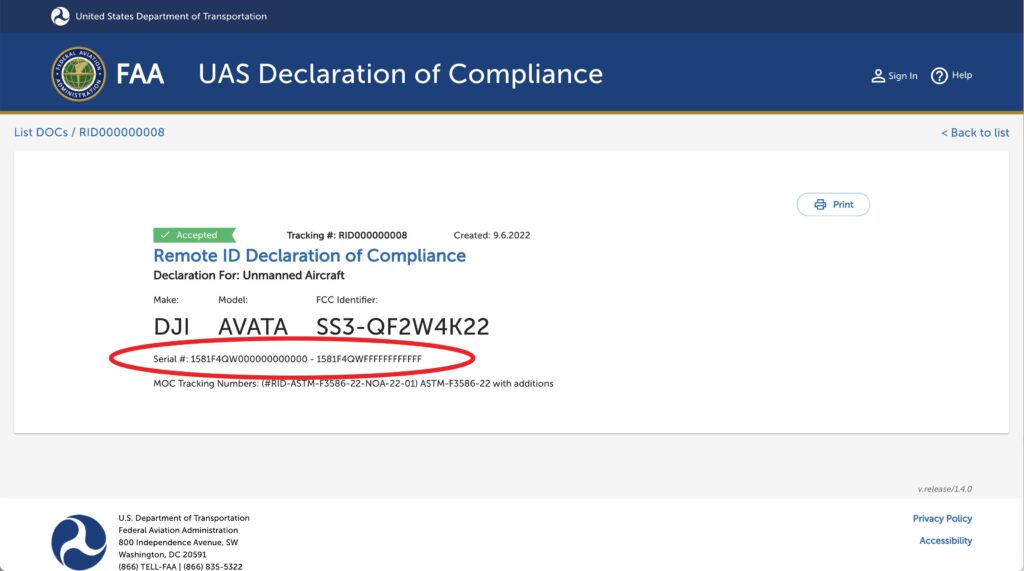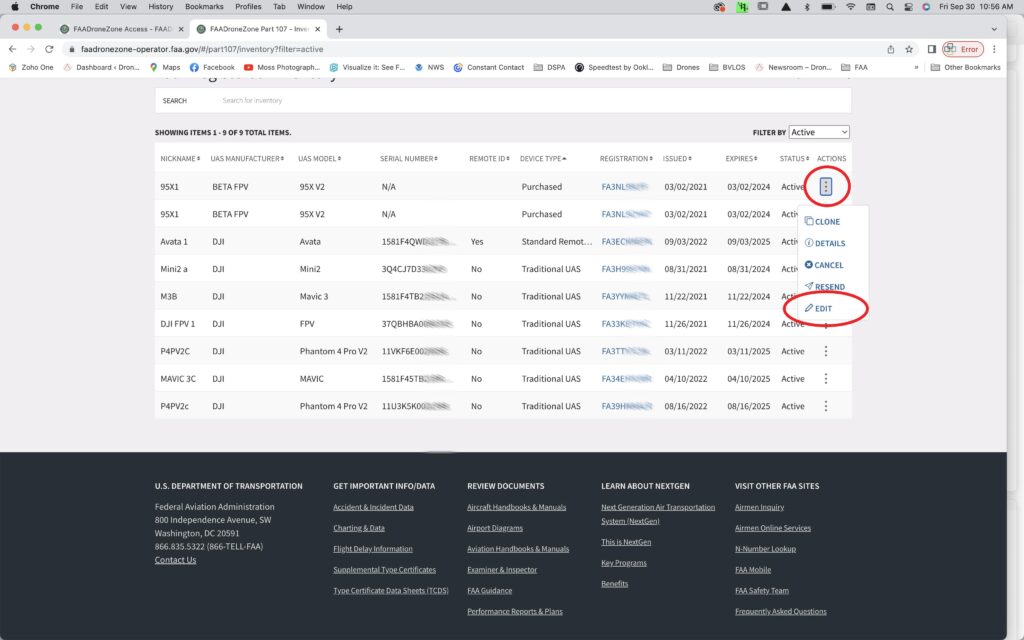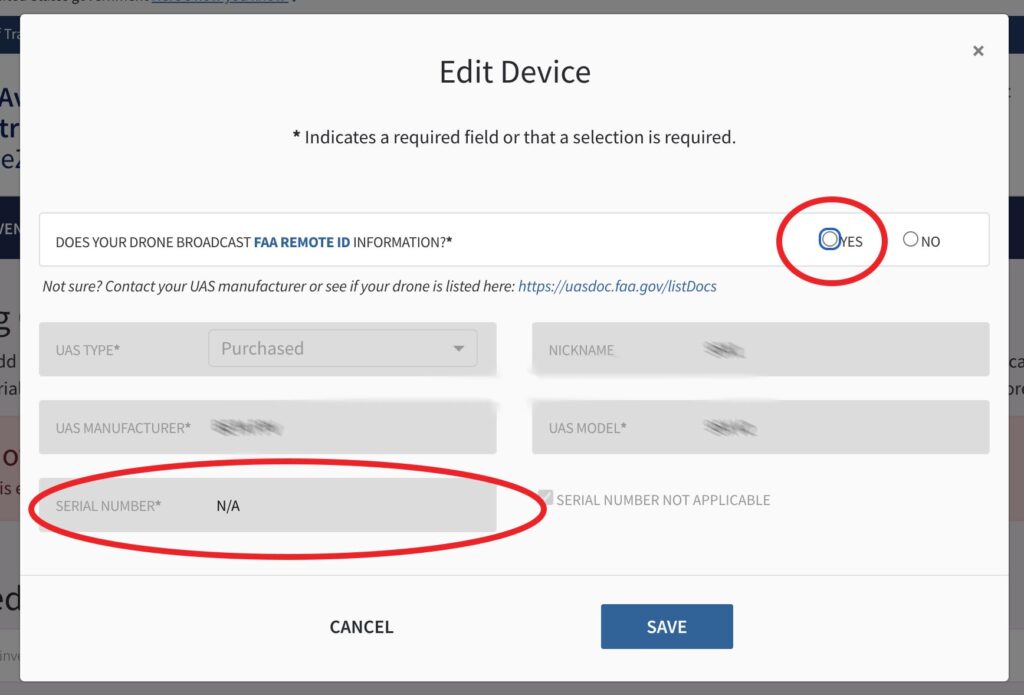Is my drone Remote ID (RID) compliant? Can I fly it over people now?
We see these two questions more than any others these days. And for good reason.
But first things first, DON’T PANIC, you literally don’t have to do a single thing until the stroke of midnight on 9.15.23 if you’re so inclined to procrastinate.
And the answer to both of those questions is “yes”., and “no”. So that really doesn’t help alleviate some of the confusion.
Let’s try and do that here.
Let’s start with the first question. Is my drone RID compliant?
Again, yes and no. But let’s tackle the “yes” first. And “it depends on your manufacturer”.
The FAA started accepting and publishing Declarations of Compliance (DOC) on 9.9.22. And that’s when much of the confusion escalated. There is a marked difference between a particular drone having an RID DOC and being compliant with actual Remote ID. The first step is to have an accepted Declaration of Compliance, then each manufacturer must then have a firmware update to make the drone’s RID package active. Some manufacturers have received RID DOCs. At the time of this writing (9.30.22) there are 18 different drones with RID DOCs, produced by seven different manufacturers.
And as of this writing, we know of no drones with RID DOCs that are also broadcasting RID. Yet. This will change.
So don’t confuse a DOC with actual broadcast compliance and capability. That will come before September 16, 2023 – which is the deadline for drone operators to have their drones compliant with 14 CFR §89.105.
So again, for now, don’t fret. You don’t need to do anything at all. And once things are ready for both changing your registration on your current drone, and becoming compliant for broadcast, there will be plenty of press to let you know. We at DSPA will certainly do our part to get the word out.
So what about your Drone Zone inventory. Can we change that yet, and how do we do it?
Again, the answer is “yes” and “no” (do you see a pattern forming…).
And this is only for drones registered on your 107 dashboard. 44809 registered drones will have a different process, and that’s not out yet. Stay tuned. When we reached out to UASHelp@faa.gov (an email address everyone should use when they have questions) and asked about the 44809 RID registration process, they said “… pending…”
If you currently have a drone in your 107 FAA Drone Zone inventory that has an RID DOC, you may be able to edit your registration. If you do, here is how you do it.
First, pull up the FAA’s DOC page and look for your drone. When you click the “View” link, you’ll see a new Serial # lighted on the DOC. That’s where you get the new serial number of your RID compliant drone. Let’s use the new DJI Avata as an example. If you pull up the DOC for the Avata, you’ll see “Serial #: 1581F4QW000000000000 – 1581F4QWFFFFFFFFFFFF”. That is your new serial number. At least the beginning part of it.

When you go to your Drone Zone inventory, check to see if “EDIT” comes up when you click on the three dots next to your drone. If so, you can edit your registration to include the new RID DOC serial number if it has one.

If “EDIT” does, and it’s actually a drone with a DOC (some say “EDIT”, but don’t have a DOC), click “yes” for RID, and edit your serial number with the new RID serial number. Except replace the “000000000000” with your drone’s actual serial number.

As an example I replaced the “000000000000” on my Avata registration with my Avata’s serial number. Now the new serial number for my Avata is “1581F4QWD227B0023L6W”. And it did not change my registration number on the Avata, and I did not have to pay $5 again.

But you do need to print out a new registration card and carry it with you, in your drone case, and/or in your Policy and Procedure Manual. Better yet, all three.
Again, don’t freak out yet, you do not have to become RID compliant until 9.16.23. You have plenty of time. But if you’re like us, and want to get stuff done early, now you know the process. So if you want to get things done as soon as possible, make it a habit to check your Drone Zone inventory on occasion and see if you can edit your registration. The FAA’s IT Department is working on updating the Drone Zone in order to make all drones with DOCs capable of RID registration. Until that happens, be patient.
Also, a quick aside…
Yes, almost all DJI drones have “Remote ID” capabilities according to their corresponding app. This is NOT the FAA’s version of Remote ID. It’s only DJI’s version, and they are NOT the same thing. DJI came out with their version of RID way before the FAA came out with theirs. The DJI RID refers to the information packet sent out to UAS monitoring equipment such as AeroScope and Aerial Armor. It’s just an unfortunate coincidence they’re called the same thing. This causes no end of confusion to many just getting into drones.
We hope this smooths some of the confusion about the difference between RID Declaration of Compliance, and RID broadcast compliance. If not, comment below and we’ll try and answer you ASAP.
So, can we fly over people with our Remote Identification DOC accepted drone?
We gave away that answer at the top of this article, “yes” and “no”.
And since we’re seeing all kinds of videos of this violation coming online (concerts, football games, parades, etc.), we’re also seeing all kinds of questions about this in forums.

The easiest question to answer is whether or not you can fly over people.
Yes, there are two ways to do that. First, get a 107.39 waiver. And those aren’t given to many. The other way is easier. You can fly a Category 1, 2, 3, or 4 Operation Over People (OOP) compliant drone. Those regulations can be found in the OOP Final Rules. You can find those starting on page 4383 of the Federal Register here.
If you have a drone that qualifies under §107.110, §107.115, §107.125, or §107.140, you can fly over people (but not “sustained flight over open-air assemblies” unless it’s also RID broadcast compliant). And since at the moment only Category 1 (§107.110) drones are available, you’re restricted to one of those. We have an article about making the DJI Mini 2 Category 1 compliant here.
And while we’re on the subject, in order to be Category 2 or 3 compliant, the manufacturer has to go through a declaration of compliance process, just like they did with the RID process. You can only self certify drones under §107.110 (Category 1).
You cannot self certify drones under Categories 2 and 3. We see many people asking about this too.
For Category 1 drones, they must weight under .55lbs (250g), and have no “… exposed rotating parts that would lacerate human skin…”. The weight restriction is easy to determine, the second part of §107.110 (laceration) is a bit more difficult. It’s up to the Remote Pilot in Command to determine if their <250g drone satisfies the laceration restriction. And no matter what you decide about prop cages or not, you better be right if there’s an incident.
Now, what about that annoying little part that says no “sustained flight over open-air assemblies” without RID. And what exactly is considered “sustained flights” by the FAA. And what about “open-air assemblies”?
We can find examples (not definitions) in the preamble of the Remote ID rule.
On page 4316 of the Preamble to the OOP Final Rule, the FAA mentions what a sustained flight could be. This includes “hovering above any person’s head, flying back and forth over an open-air assembly, or circling above an uninvolved person in such a way that the small unmanned aircraft remains above some part of that person.”
There is certainly some room for interpretation in that statement. But that’s a double edged sword for Drone Pilots. In one vein, the FAA is giving us latitude to make our own decisions, at least in part. They’ve decided that we have the knowledge and integrity to make our own decision on what constitutes sustained. Within reason of course.
Which bring us to the second vein, you better be right in your decision. The phrase “enough rope to hang yourself” comes to mind…
Let’s circle back to “open-air assemblies” for a bit. We can find examples of that in the OOP preamble too. These are only a partial list of what the FAA calls “potential examples”, so be judicious in your own definition. The FAA includes the following as “potential examples” in the OOP preamble on page 4363, “sporting events, concerts, parades, protests, political rallies, community festivals, or parks and beaches during certain events.”
They even include some “potential examples” of what may not be considered open-air assemblies. That’s nice of them. They include, “individual persons or families exiting a shopping center, athletes participating in friendly sports in an open area without spectators, individuals or small groups taking leisure in a park or on a beach, or individuals walking or riding a bike along a bike path”.
There is even further instructions given to Remote Pilots about what defines open-air assembly in that paragraph. They write, “… but whether an open-air assembly exists depends on a case-by-case determination based on the facts and circumstances of each case. The remote pilot must assess whether the operational area would be considered an open-air assembly prior to conducting flight operations.”
There are currently no drone-centric legal definitions of “open-air assembly” on the FAA’s Legal Interpretations and Chief Counsel’s Opinions page.
So as the Grail Knight says in Indiana Jones and the Last Crusade, “Choose wisely”. And based on the FAA’s reaction to some of the OOP violation videos we’ve seen, the Grail Knight’s advice is good advice indeed.

Help us continue to fight unnecessary drone regulations at the local and national level. Join us or donate.
